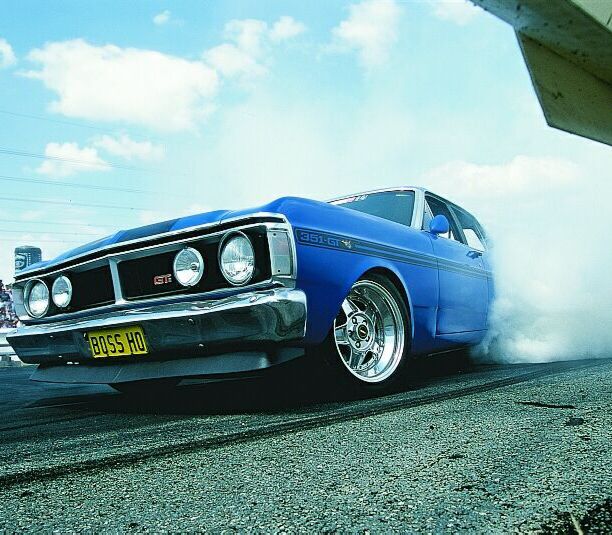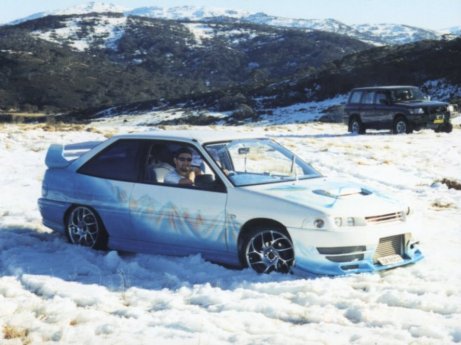|
Welcome to my Ford Fame Page!
FORD IS BACK!,BETTER,BIGGER,STRONGER,MORE GRUNT AND UNSTOPABLE ENGINES THAT ARE GONNA BLAST THOSE SHITTY HOLDENS AWAY! 26TH OF MAY WILL BE THE DAY WE ALL GET TO SEE AND HEAR ABOUT THE NEW AV FALCON 4 NEW ENGINES,NEW HEART POUNDING PERFORMANCE AND TAILORED INTERIOR.FORD-WE HAVE IGNITION.
THE OUT COME: FORD GONNA KICK ASS!
The GT HO SuperFalcon
There were only two GTHO's ever built by Ford Motor Company of Australia. This pair were not Phase I, II, III or IV's they were not even XW or XYs. They were just GTHOs and were aptly code named the Super Falcons. Born to win the Australian Touring Car Championship, they came with factory lightweight body shells, 620 HP fuel injected full house motors. If you let your imagination run riot in your wildest dreams you could never build a HO like this pair. They had everything from magnesium door hinges, 10 grand tachos and 10 inch minilites to full floating Holman and Moody rear ends and boy could they go. Big Al Turner conceived them and Howard Marsden mothered them at birth. John Wynne hand built each car in a closed section of Ford Special Vehicles Lot 6, Mahoneys Road. The motors were put together by Bill Santuccione and designed by Ian Stockings, described as two guys behind the worlds screamingest Clevos (9600 revs and 620 HP exfactory). The cars were destined for the two giants of Improved Production Racing Big Pete Geoghegan and Allan Moffat. Sadly only one car remains, the Castrol car of Haberfield Fats.
Work started on the project accompanied by absolute secrecy in early 1970. Under pressure from management, Special Vehicles produced the first car for Allan Moffat at Calder on August 16th. The motivation was provided by a worn-out series production engine fitted with a massive fuel injection system. Twelve men were needed to push the Secret Weapon and coax it into doing the one lap required by management.
The first time the HO actually got her gloves up was at the last round of the Championship at Symonds Plains in November 1970. This time it completed two laps of the first practice session smoke billowing from underneath. Moffat next emerged to do four quick laps in the last five minutes in practice. He secured pole position with a 63.1 second time but blew the engine as he crossed the start/finish line. That was the end of motor racing for that weekend. For interest, Jim McKeowns fastest lap in winning the race the next day was 67.1 so the HO was no slouch, but reliability was not its long suit. That was the end of the Championships for 1970 and the last time the HO would ever appear in XW form, although both cars retained the XW GT badges on the front guards throughout their careers. The general consensus amongst the touring car set was that if ever they could keep the thing together, it would be an awesome beast. The GT HO Superfalcon pumped 620bhp of shere power!!
Fords 4cylinder hero
In 1990 Ford Australia slipped a special version of the Laser onto the market. It was more than half as expensive again as the cheapest Laser but, from a driving enthusiast's viewpoint, it was much more than twice the car.
The KF version of the TX3 Turbo used a 1.8-litre engine with 117 kW of power instead of the 100 kW 1.6 that the previous "bubble-shaped" model had shared with the Capri Turbo convertible. This made the hotshot Laser the most powerful four-cylinder Ford sold in Australia.
The combination of a powerful turbo engine and all-wheel-drive transformed the shopping hatch Laser into an extremely competent high performance car with remarkably few faults.
Don't expect to buy one with automatic transmission, since no such variant was offered. Even Ford's trendy Capri Turbo could not match the performance of the 1990-1993 TX3.
Two minor model changes were made during the three years this car was available. The KH facelift came in October 1991 and the KH Series II (with central locking as standard) followed 12 months later.
So why wasn't the TX3 Turbo 4WD a drive-away success with buyers? The appearance doubtless had something to do with the slow sales performance.
Alloy wheels and three-door hatch bodywork marked this as a sporty version but the lines were still too chunky. The interior, too, was Laser-drab, full of grey plastic and not sufficiently different from cheaper variants.
And it still carried the unassuming Laser badge. The enhanced mechanicals did not confer charisma.
For many prospective buyers it was simply invisible: they hadn't heard of it or, if they had, did not understand its potential. Arguably, the Laser badge did the TX3 no favours.
On the road, the TX3 Turbo was brilliant. With fantastic grip and stability, it could outperform many far more powerful cars, as successes in production car racing at Mount Panorama demonstrated.
Acceleration was always impressive, and in wet conditions the TX3 really distinguished itself. This model may have been expensive for a Laser but it was cheap compared with any other car with comparable dynamic prowess - a four-wheel-drive Audi sedan, for example.
Small wonder, then, that this small wonder proved extremely popular with competition drivers both for racing and rallying. It is well worth checking any TX3 you're thinking of buying for evidence of previous competition history and avoiding it accordingly.
Even when raced, the car gave very little trouble, so a well-maintained used example that has seen service no more demanding than the occasional drive to Newcastle should go for many more years without maintenance woes.
The usual exhaustive checks should be performed before purchase but a drive around a supermarket parking lot will disclose any problems with CV joints. Listen for a clicking sound when on full lock (in both directions). Replacing all four CV joints could separate you from $1,000. The camshaft belt must be changed at 100,000 km intervals.
Unlike some high performance cars, the TX3 Turbo 4WD doesn't need to be driven with verve to deliver satisfactory results. Excellent fuel economy and the versatility of a hatchback are built-in attributes. Power steering makes parking effortless. And spare parts are mostly quite cheap because it remains a Laser. Being a Laser has its advantages.The Ford Laser tx3 turbo 4wd can manage a 15.9sec down the 1/4.
Washing and Waxing Tips
Most cars now come with a clearcoat finish, which tricks owners into thinking they don't need wax. Actually, you should wax your car 3-4 times a year. Most manufacturers also recommend washing your car once a week. Remember to start washing your car only when the car's surface is cool and only after rinsing the entire car. Rub gently, one section at a time, and use specific car wash products--never household cleaners. After rinsing your car well, dry it with a soft, clean cloth.
Drop us an email!!! :)
|
FORD Fame around the world
The Ford XY GT HO Phase III was the worlds fastest 4 door production car and was Australia's fastest production car for many years.Boosting a massive 291kw's this car had a lot of go,Mighty Ford Power!
Want More Pic's?
Cant find the car your looking for then click on the link below!!
ALL FORD DAY |





